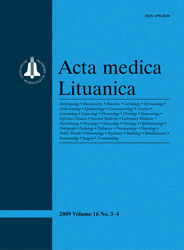 ISSN 1392-0138 ISSN 2029-4174 (online) |
2008 m. Nr. 4 Human neutrophil peptide 2 impairs wound-induced migration of cultured pulmonary artery endothelial cells
Introduction. Human neutrophil peptides (HNP) or α-defensins are cysteine-rich cationic polypeptides that possess a wide range of antimicrobial and cytotoxic capabilities. Inflammatory processes, such as neutrophil infiltration and HNP release, are present in the patient lungs associated with chronic obstructive pulmonary disease (COPD). We sought to determine whether presence of HNP impairs wound-promoted migration of lung endothelial cells in vitro. Materials and methods. Cultured porcine pulmonary artery endothelial cells (PAEC) were used as cell models to investigate the effects of HNP on wound-induced migration. Cells were HNP-treated and their metabolic activity was assessed using WST-1 assay. Wounds were induced in the cell monolayer incubated in the medium containing 0–100 nM HNP-2. Cell morphology and migration were examined under a confocal microscope. In parallel, fluoresceinlabelled HNP-2 was applied and its internalization into PAEC was assessed. Results. HNP-2 attenuated in vitro wound-induced endothelial migration in dose-dependent manner. HNP-2 at the concentrations of 15 to 100 nM did not affect the cell viability. Labelled HNP-2 was internalized by PAEC. Conclusions. Our results suggest that HNP can attenuate wound-induced endothelial migration, which may be associated with the internalization of the peptide. HNP may contribute to the loss of lung vasculature in the development of COPD and other inflammatory conditions. Keywords: neutrophil degranulation products, defensins, human neutrophils peptides, cationic peptides, endothelial permeability |
Issues:
2011 - Vol.18 No. 1, No. 2, No. 3, No. 4 2010 - Vol.17 No. 1-2, No. 3-4 2009 - Vol.16 No. 1-2, No. 3-4 2008 - Vol.15 No. 1, No. 2, No. 3, No. 4 2007 - Vol.14 No. 1, No. 2, No. 3, No. 4 2006 - Vol.13 No. 1, No. 2, No. 3, No. 4 2005 - Vol.12 No. 1, No. 2, No. 3, No. 4 2004 - Vol.11 No. 1, No. 2, No. 3, No. 4 2003 - Vol.10 No. 1, No. 2, No. 3, No. 4 2002 - Vol.9 No. 1, No. 2, No. 3, No. 4 2001 - Vol.8 No. 1, No. 2, No. 3, No. 4 |